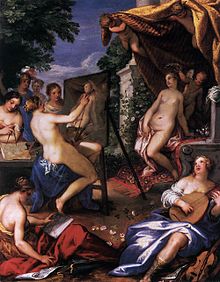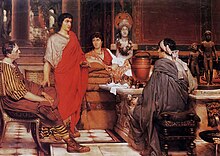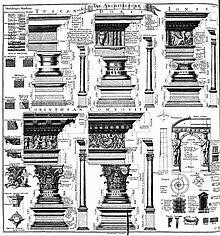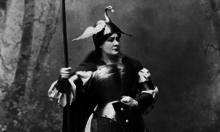Redaktor:Zabka1971/pieskovisko/preklady/Druhy umenia

Druhy umenia označujú teóriu a fyzické vyjadrenie tvorivosti, ktorá sa vyskytuje v ľudských spoločnostiach a kultúrach. Medzi hlavné zložky umenia patrí literatúra (vrátane drámy, poézie a prózy), múzické umenia (medzi nimi tanec, hudba a divadlo), a výtvarné umenie (vrátane architektúry, keramiky, kresby, maliarstva, fotografie, a sochárstva).[chýba zdroj]
Niektoré umelecké formy kombinujú vizuálne prvky s výkonom účinkujúceho (napr., kinematografia) alebo umelecké dielo s písaným slovom (napr., komiks). Od prehistorických jaskynných malieb po dnešné filmy, umenie slúži ako prostriedok na rozprávanie príbehov a vyjadrenie vzťahu ľudstva k prostrediu, v ktorom žije.[chýba zdroj]
Vymedzenie pojmov[upraviť | upraviť zdroj]
Podľa najzákladnejšej abstraktnej definície umenie je dokumentované vyjadrenie vnímavej bytosti na dostupnom médiu alebo jeho prostredníctvom tak, aby ho iní dokázali vidieť, počuť alebo vnímať. Samotná tvorba tohoto vyjadrenia môže byť tiež považovaná za určité umenie alebo za umenie vo všeobecnosti. To, či je takéto dokonané vyjadrenie alebo akt jeho vytvorenia "dobrý" alebo či má hodnotu, závisí od tých, ktorí k nemu pristupujú a hodnotia ho pričom toto verejné hodnotenie závisí na rôznych subjektívnych faktoroch. Merriam-Webster definuje "umenie" ako "maliarstvo, sochárstvo, hudbu, divadlo, literatúru, atď., považované za skupinu aktivít, ktoré vykonávajú zruční ľudia s predstavivosťou."[1] Podobne Kongres Spojených štátov v zákone National Foundation on the Arts and Humanities Act definuje "umenie" nasledovne:[2]
Pojem 'umenie' zahŕňa ale nie je obmedzený na hudbu (inštrumentálnu alebo vokálnu), tanec, divadlo, ľudové umenie, kreatívne písanie, architektúru a príbuzné odbory, maliarstvo, sochárstvo, fotografiu, grafické a remeselné umenia, priemyselný dizajn, návrh kostýmov a oblečenia, animáciu, televíziu, rozhlas, film, video, zvukové nahrávky, schopnosti so vzťahom ku prezentácií, predvádzaniu, vykonávaniu a vystavovaniu takýchto hlavných foriem umenia, všetky takéto tradičné umenia praktizované rôznymi ľuďmi v tejto krajine. (sic) a štúdium a aplikáciu umenia na prostredie ľudskej spoločnosti.
História[upraviť | upraviť zdroj]
V starovekom Grécku všetky umenia a remeslá označovalo rovnaké slovo, techné. Preto sa medzi druhmi umenia nerozlišovalo. Storogrécke umenie prinieslo uctievanie zvieracej formy a rozvoj schopností potrebných na zobrazenie svalov, postoja, krásy a anatomicky korektných proporcií. Umenie starého Ríma zobrazuje bohov ako idealizované ľudské bytosti s charakteristickými význačnými črtami (napr. Diov blesk). V byzantskom a gotickom umení stredoveku dominantná cirkev zdôrazňovala vyjadrovanie biblickej nie materiálnej pravdy. Ázijské umenie vo všeobecnosti pracovalo štýlom podobným západnému stredovekému umeniu, totiž sústredením na povrchové vzory a lokálnu farbu (v zmysle jednoliatej farby objektu ako napríklad základná červená pri červenom rúchu miesto modulácií farby vplyvom svetla, tieňa a odrazov). Pre tento štýl je charakteristické, že lokálna farba je často vymedzená obrysom (moderným ekvivalentom je kreslený vtip). Toto sa prejavuje napríklad v indickom, tibetskom a japonskom umení. Náboženské islamské umenie zakazuje ikonografiu a namiesto toho vyjadruje náboženské myšlienky prostredníctvom geometrie.
Klasifikácia[upraviť | upraviť zdroj]

V stredoveku sa Artes Liberales (slobodné umenia) vyučovali na univerzitách ako súčasť trívia, úvodného študijného plánu, ktorý zahŕňal gramatiku rétoriku a logiku,[3] a ako súčasť kvadrívia, študijného plánu, ktorý zahŕňal "matematické umenia" čiže artmetiku, geometriu, hudbu a astronómiu.[4] The Artes Mechanicae (pozostáva z vestiaria – krajčírstvo a tkanie; agricultura – poľnohospodárstvo; architectura – architektúra a murárstvo; militia a venatoria – boj, lov, vojenské vzdelávanie, and the bojové umenia; mercatura – obchod; coquinaria – varenie; a metallaria – kováčstvo and metalurgia)[5] were practised and developed in guild environments. The modern distinction between "artistic" and "non-artistic" skills did not develop until the Renaissance. In modern academia, the arts are usually grouped with or as a subset of the humanities. Some subjects in the humanities are history, linguistics, literature, theology, philosophy, and logic.
The arts have also been classified as seven: painting, architecture, sculpture, literature, music, performing and cinema.
Some view literature, painting, sculpture, and music as the main four arts, of which the others are derivative; drama is literature with acting, dance is music expressed through motion, and song is music with literature and voice.[6]
Visual arts[upraviť | upraviť zdroj]
Šablóna:Main article Šablóna:Further information
Architecture[upraviť | upraviť zdroj]

Architecture is the art and science of designing buildings and structures. The word architecture comes from the Greek arkhitekton, "master builder, director of works," from αρχι- (arkhi) "chief" + τεκτων (tekton) "builder, carpenter".[7] A wider definition would include the design of the built environment, from the macrolevel of town planning, urban design, and landscape architecture to the microlevel of creating furniture. Architectural design usually must address both feasibility and cost for the builder, as well as function and aesthetics for the user.

In modern usage, architecture is the art and discipline of creating, or inferring an implied or apparent plan of, a complex object or system. The term can be used to connote the implied architecture of abstract things such as music or mathematics, the apparent architecture of natural things, such as geological formations or the structure of biological cells, or explicitly planned architectures of human-made things such as software, computers, enterprises, and databases, in addition to buildings. In every usage, an architecture may be seen as a subjective mapping from a human perspective (that of the user in the case of abstract or physical artifacts) to the elements or components of some kind of structure or system, which preserves the relationships among the elements or components. Planned architecture manipulates space, volume, texture, light, shadow, or abstract elements in order to achieve pleasing aesthetics. This distinguishes it from applied science or engineering, which usually concentrate more on the functional and feasibility aspects of the design of constructions or structures.
In the field of building architecture, the skills demanded of an architect range from the more complex, such as for a hospital or a stadium, to the apparently simpler, such as planning residential houses. Many architectural works may be seen also as cultural and political symbols, or works of art. The role of the architect, though changing, has been central to the successful (and sometimes less than successful) design and implementation of pleasingly built environments in which people live.
Ceramics[upraviť | upraviť zdroj]
Ceramic art is art made from ceramic materials (including clay), which may take forms such as pottery, tile, figurines, sculpture, and tableware. While some ceramic products are considered fine art, some are considered to be decorative, industrial, or applied art objects. Ceramics may also be considered artefacts in archaeology.Ceramic art can be made by one person or by a group of people. In a pottery or ceramic factory, a group of people design, manufacture, and decorate the pottery. Products from a pottery are sometimes referred to as "art pottery." In a one-person pottery studio, ceramists or potters produce studio pottery. In modern ceramic engineering usage, "ceramics" is the art and science of making objects from inorganic, non-metallic materials by the action of heat. It excludes glass and mosaic made from glass tesserae.
Conceptual art[upraviť | upraviť zdroj]
Conceptual art is art in which the concept(s) or idea(s) involved in the work takes precedence over traditional aesthetic and material concerns. The inception of the term in the 1960s referred to a strict and focused practice of idea-based art that often defied traditional visual criteria associated with the visual arts in its presentation as text.[8] Through its association with the Young British Artists and the Turner Prize during the 1990s,[chýba zdroj] its popular usage, particularly in the UK, developed as a synonym for all contemporary art that does not practise the traditional skills of painting and sculpture.
Drawing[upraviť | upraviť zdroj]
Drawing is a means of making an image, using any of a wide variety of tools and techniques. It generally involves making marks on a surface by applying pressure from a tool, or moving a tool across a surface. Common tools are graphite pencils, pen and ink, inked brushes, wax colour pencils, crayons, charcoals, pastels, and markers. Digital tools which can simulate the effects of these are also used. The main techniques used in drawing are line drawing, hatching, crosshatching, random hatching, scribbling, stippling, and blending. An artist who excels in drawing is referred to as a drafter, draftswoman, or draughtsman.[9] Drawing can be used to create art used in cultural industries such as illustrations, comics and animation.
Painting[upraviť | upraviť zdroj]

Painting is a mode of creative expression, and can be done in numerous forms. Drawing, gesture (as in gestural painting), composition, narration (as in narrative art), or abstraction (as in abstract art), among other aesthetic modes, may serve to manifest the expressive and conceptual intention of the practitioner.[10] Paintings can be naturalistic and representational (as in a still life or landscape painting), photographic, abstract, narrative, symbolistic (as in Symbolist art), emotive (as in Expressionism), or political in nature (as in Artivism).
Modern painters have extended the practice considerably to include, for example, collage. Collage is not painting in the strict sense since it includes other materials. Some modern painters incorporate different materials such as sand, cement, straw, wood or strands of hair for their artwork texture. Examples of this are the works of Elito Circa, Jean Dubuffet or Anselm Kiefer.
Photography[upraviť | upraviť zdroj]
Photography as an art form refers to photographs that are created in accordance with the creative vision of the photographer. Art photography stands in contrast to photojournalism, which provides a visual account for news events, and commercial photography, the primary focus of which is to advertise products or services.
Sculpture[upraviť | upraviť zdroj]
Sculpture is the branch of the visual arts that operates in three dimensions. It is one of the plastic arts. Durable sculptural processes originally used carving (the removal of material) and modelling (the addition of material, as clay), in stone, metal, ceramics, wood and other materials; but since modernism, shifts in sculptural process led to an almost complete freedom of materials and process. A wide variety of materials may be worked by removal such as carving, assembled by welding or modelling, or moulded, or cast.
Literary arts[upraviť | upraviť zdroj]
Šablóna:Main article Šablóna:Listen
Literature is literally "acquaintance with letters" as in the first sense given in the Oxford English Dictionary. The noun "literature" comes from the Latin word littera meaning "an individual written character (letter)." The term has generally come to identify a collection of writings, which in Western culture are mainly prose (both fiction and non-fiction), drama and poetry. In much, if not all of the world, the artistic linguistic expression can be oral as well, and include such genres as epic, legend, myth, ballad, other forms of oral poetry, and as folktale. Comics, the combination of drawings or other visual arts with narrating literature, are often called the "ninth art" (le neuvième art) in Francophone scholarship.[11]
Performing arts[upraviť | upraviť zdroj]
Performing arts comprise dance, music, theatre, opera, mime, and other art forms in which a human performance is the principal product. Performing arts are distinguished by this performance element in contrast with disciplines such as visual and literary arts where the product is an object that does not require a performance to be observed and experienced. Each discipline in the performing arts is temporal in nature, meaning the product is performed over a period of time. Products are broadly categorized as being either repeatable (for example, by script or score) or improvised for each performance.[12] Artists who participate in these arts in front of an audience are called performers, including actors, magicians, comedians, dancers, musicians, and singers. Performing arts are also supported by the services of other artists or essential workers, such as songwriting and stagecraft. Performers often adapt their appearance with tools such as costume and stage makeup.
Music[upraviť | upraviť zdroj]

 Play
PlayMusic is an art form whose medium is sound and silence, occurring in time. Common elements of music are pitch (which governs melody and harmony), rhythm (and its associated concepts tempo, metre, and articulation), dynamics, and the sonic qualities of timbre and texture. The creation, performance, significance, and even the definition of music vary according to culture and social context. Music ranges from strictly organized compositions (and their reproduction in performance) through improvisational music to aleatoric pieces. Music can be divided into genres and subgenres, although the dividing lines and relationships between music genres are often subtle, sometimes open to individual interpretation, and occasionally controversial. Within "the arts," music may be classified as a performing art, a fine art, and auditory art.
Theatre[upraviť | upraviť zdroj]
Theatre or theater (from Greek theatron (θέατρον); from theasthai, "behold")[13] is the branch of the performing arts concerned with acting out stories in front of an audience using combinations of speech, gesture, music, dance, sound and spectacle – indeed, any one or more elements of the other performing arts. In addition to the standard narrative dialogue style, theatre takes such forms as opera, ballet, mime, kabuki, classical Indian dance, Chinese opera and mummers' plays.
Dance[upraviť | upraviť zdroj]

Dance (from Old French dancier, of unknown origin)[14] generally refers to human movement either used as a form of expression or presented in a social, spiritual or performance setting. Dance is also used to describe methods of non-verbal communication (see body language) between humans or animals (e.g. bee dance, mating dance), motion in inanimate objects (e.g. the leaves danced in the wind), and certain musical forms or genres. Choreography is the art of making dances, and the person who does this is called a choreographer. Definitions of what constitutes dance are dependent on social, cultural, aesthetic, artistic and moral constraints and range from functional movement (such as Folk dance) to codified, virtuoso techniques such as ballet. In sports, gymnastics, figure skating and synchronized swimming are dance disciplines while Martial arts "kata" are often compared to dances.
Multidisciplinary artistic works[upraviť | upraviť zdroj]
Areas exist in which artistic works incorporate multiple artistic fields, such as film, opera and performance art. While opera is often categorized in the performing arts of music, the word itself is Italian for "works", because opera combines several artistic disciplines in a singular artistic experience. In a typical traditional opera, the entire work utilizes the following: the sets (visual arts), costumes (fashion), acting (dramatic performing arts), the libretto, or the words/story (literature), and singers and an orchestra (music).

The composer Richard Wagner recognized the fusion of so many disciplines into a single work of opera, exemplified by his cycle Der Ring des Nibelungen ("The Ring of the Nibelung"). He did not use the term opera for his works, but instead Gesamtkunstwerk ("synthesis of the arts"), sometimes referred to as "Music Drama" in English, emphasizing the literary and theatrical components which were as important as the music. Classical ballet is another form which emerged in the 17th century in which orchestral music is combined with dance.
Other works in the late 19th, 20th and 21st centuries have fused other disciplines in unique and creative ways, such as performance art. Performance art is a performance over time which combines any number of instruments, objects, and art within a predefined or less well-defined structure, some of which can be improvised. Performance art may be scripted, unscripted, random or carefully organized; even audience participation may occur. John Cage is regarded by many as a performance artist rather than a composer, although he preferred the latter term. He did not compose for traditional ensembles. Cage's composition Living Room Music composed in 1940 is a "quartet" for unspecified instruments, really non-melodic objects, which can be found in a living room of a typical house, hence the title.
Other arts[upraviť | upraviť zdroj]
There is no clear line between art and culture. Cultural fields like gastronomy are sometimes considered as arts.[15]
Applied arts[upraviť | upraviť zdroj]
Šablóna:Main article The applied arts are the application of design and decoration to everyday, functional, objects to make them aesthetically pleasing.[16] The applied arts includes fields such as industrial design, illustration, and commercial art.[17] The term "applied art" is used in distinction to the fine arts, where the latter is defined as arts that aims to produce objects which are beautiful or provide intellectual stimulation but have no primary everyday function. In practice, the two often overlap.
Video games[upraviť | upraviť zdroj]
A debate exists in the fine arts and video game cultures over whether video games can be counted as an art form.[18] Game designer Hideo Kojima professes that video games are a type of service, not an art form, because they are meant to entertain and attempt to entertain as many people as possible, rather than being a single artistic voice (despite Kojima himself being considered a gaming auteur, and the mixed opinions his games typically receive). However, he acknowledged that since video games are made up of artistic elements (for example, the visuals), game designers could be considered museum curators – not creating artistic pieces, but arranging them in a way that displays their artistry and sells tickets.
Within social sciences, cultural economists show how video games playing is conducive to the involvement in more traditional art forms and cultural practices, which suggests the complementarity between video games and the arts.[19]
In May 2011, the National Endowment of the Arts included video games in its redefinition of what is considered a "work of art" when applying of a grant.[chýba zdroj] In 2012, the Smithsonian American Art Museum presented an exhibit, The Art of the Video Game.[18] Reviews of the exhibit were mixed, including questioning whether video games belong in an art museum.
Arts criticism[upraviť | upraviť zdroj]
- Architecture criticism
- Art criticism
- Dance criticism
- Film criticism
- Music criticism
- Television criticism
- Theatre criticism
See also[upraviť | upraviť zdroj]
References[upraviť | upraviť zdroj]
- ↑ Definition of The Arts. Merriam-Webster. Dostupné online [cit. 2017-05-14]. (po anglicky)
- ↑ VAN CAMP, Julie. Congressional definition of "the arts" [online]. California State University, Long Beach, 22 November 2006. Dostupné online. (po anglicky)
- ↑ ONIONS, C. T; FRIEDRICHSEN, George Washington Salisbury; BURCHFIELD, Robert William. The Oxford dictionary of English etymology. Oxford : at The Clarendon Press, 1991. ISBN 978-0198611127. S. 994. (po anglicky)
- ↑ Šablóna:Cite wikisource
- ↑ In his commentary on Martianus Capella's early fifth century work, The Marriage of Philology and Mercury, one of the main sources for medieval reflection on the liberal arts
- ↑ ROWLANDS, Joseph; LANDAUER, Jeff. Esthetics [online]. 2001. Dostupné online.
- ↑ HARPER, Douglas. architect (n.) [online]. Online Etymology Dictionary, 2001–2016. Dostupné online. (po anglicky)
- ↑ Conceptual art [online]. Tate, [cit. 2017-05-14]. Dostupné online. (po anglicky)
- ↑ The definition of draftsman [online]. . Dostupné online.
- ↑ The Music of Painting. The American Scholar, Summer 2014, s. 85.
- ↑ MILLER, Ann. Reading bande dessinée : critical approaches to French-language comic strip. [s.l.] : [s.n.], 2007. ISBN 9781841501772. S. 23.
- ↑ HONDERICH, Ted. The Oxford companion to philosophy. [s.l.] : Oxford University Press, 2006. ISBN 9780199264797. DOI:10.1093/acref/9780199264797.001.0001 (po anglicky)
- ↑ HARPER, Douglas. theater (n.) [online]. Online Etymology Dictionary, 2001–2016. Dostupné online. (po anglicky)
- ↑ HARPER, Douglas. dance (n.) [online]. Online Etymology Dictionary, 2001–2016. Dostupné online. (po anglicky)
- ↑ The New Face of French Gastronomy - Knowledge@Wharton [online]. Knowledge.wharton.upenn.edu, 2013-12-20, [cit. 2018-05-08]. Dostupné online.
- ↑ "applied art" in The Oxford Dictionary of Art. Online edition. Oxford University Press, 2004. www.oxfordreference.com. Retrieved 23 November 2013.
- ↑ Applied art | Define Applied art at [online]. Dictionary.com, [cit. 2018-05-08]. Dostupné online.
- ↑ a b PARKER, Felan. An Art World for Artgames. Loading..., 12 December 2012. Dostupné online. ISSN 1923-2691. (po anglicky)
- ↑ Video Games Playing: A substitute for cultural consumptions?. Journal of Cultural Economics, 2015, s. 239–258. DOI: 10.1007/s10824-014-9229-y. (po anglicky)
Further reading[upraviť | upraviť zdroj]
- The Art of Video Games [online]. Smithsonian American Art Museum, [cit. 2015-03-07]. Dostupné online.
- BARRON, Christina. Museum exhibit asks: Is it art if you push ‘start’?. The Washington Post, 29 April 2012. Dostupné online [cit. 2013-02-12].
- Conceptual art [online]. [Cit. 2015-03-07]. Dostupné online.
- FEYNMAN, Richard. QED: The Strange Theory of Light and Matter. [s.l.] : Princeton University Press, 1985. ISBN 978-0691024172.
- FY 2012 Arts in Media Guidelines [online]. National Endowment for the Arts, [cit. 2015-03-07]. Dostupné online. Archivované 2012-02-13 z originálu.
- GIBSON, Ellie. Games aren't art, says Kojima [online]. Gamer Network, 24 January 2006, [cit. 2015-03-07]. Dostupné online.
- KENNICOTT, Philip. The Art of Video Games. The Washington Post, 18 March 2012. Dostupné online [cit. 2013-02-12].
